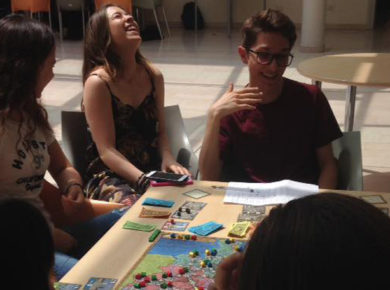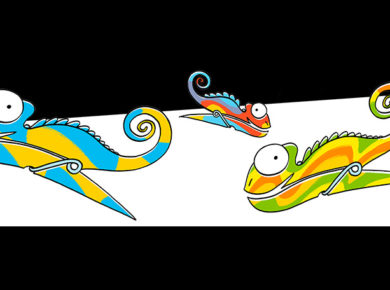BoardGames @ School: a first case study [BoardGameAgent]
Some weeks ago Russell Haliday told me he was starting a web site, “The Board Game Agent“, where collect experience all around the world about using board games to help derive social or academic benefits. I decided to contribute to his site writing my experience in schools with 7-8 years old kids.
Can normal board games be successfully used in schools? Can board games be a vehicle to improve competencies and skills that standard teaching methods aren’t able to stimulate?
This case study comes to us all the way from Italy. Andrea Ligabue (“Liga”), the “Ludologo”, is a board games expert and well-known reviewer, who writes articles for Opinionatedgamers.com, BGG news, and Gamers Alliance Report. He is a member of the International Gamers Awards committee. Since 2010, Liga has been working as a freelance professional games consultant for publishers, schools, and institutions. In the spare time he runs his own blog at www.ludologo.com
Can normal board games be successfully used in schools? Can board games be a vehicle to improve competencies and skills that standard teaching methods aren’t able to stimulate?
Of course, for me, the answers to these questions are “yes”. This article is a report of my experience teaching with games in school with classes of 7-8 year old kids as an external expert consultant in support to the students’ regular teacher.
 To start, I conducted a workshop with teachers: 1 hour of theory and 2 hours of practice. In the theory session I talked about the difference between normal (mainstream) board games and games specifically built for teaching. I presented some games then I explained Takenoko and let the teacher play an almost full game. Takenoko is a perfect game to show how games can be used in teaching: it is simple, nice to see, and stimulate both tactical and strategic thinking. You can introduce important topics like the weight of the luck, interaction, complexity.
To start, I conducted a workshop with teachers: 1 hour of theory and 2 hours of practice. In the theory session I talked about the difference between normal (mainstream) board games and games specifically built for teaching. I presented some games then I explained Takenoko and let the teacher play an almost full game. Takenoko is a perfect game to show how games can be used in teaching: it is simple, nice to see, and stimulate both tactical and strategic thinking. You can introduce important topics like the weight of the luck, interaction, complexity.
In the experience in the classroom I used Super Farmer, Kaleidos and Jamaica. Not all the classes were really at the same level: in some classes I have done just 2 games, in other all 3 of the games. In most of the classes I had 4 hours (two lessons of one hour each).
Here some aspects common to all of my gaming lessons. I usually spend 5-10 minutes in presenting myself, talking about games in general and preparing the class. This is a sort of briefing. The kids are divided into groups/tables of around 8 children each. Every player in the game is actually played by 2 or 3 children. That is an important difference between free gaming and schools gaming. Kids alone are not truly pushed into thinking about what they are doing. With 2-3 kids playing together, they need to persuade each other which is the best move and are forced to think much more. They can also help each other and the teacher can make the groups in the way they prefer (working on the differences or on the competitions on the synergies). It has worked well to ask the teacher to think about groups before the lesson.
Then there is the rules explanation. I try to be clear as much as possible in this phase and engage the kids with examples and questions. Of course during this phase is important that the children have the game in front of them but generally not all the components (otherwise with young kids they are distracted by the materials). When I’m sure the rules are OK we start the game session. During the game I and the teacher move from one table to another one. With a normal (Italian) class of 24-25 kids they are organized in 3 tables. It is important to let the kids play without interfering too much. Observe whether there are illustrative situations to talk about.
The last part of the lesson is a debriefing. Is it important to talk with kids about the game asking their impressions: did you like it? Yes/no/why? Too much luck? Impressions? Is it also a good moment to ask kids about their gaming culture: how many games do they know about? How many times they are used to playing at home.
Now, let’s go into detail with the games used.
I like this game for kids in the 1st and 2nd class of primary school where they are learning base math: additions and starting to learn the progression of the 2 (2-4-6-…).
The game is nice because it is simple, there are good materials, some important decisions, a little luck and a lot of math.
I suggest a quicker start, usually 3 rabbits or 1 rabbit and 1 sheep. The first turn of the normal game are slow and do not really help in a school activity. When the amount of rabbits start to grow they will start to ask: “I want a sheep”, “I want a pig”. This is the time to stop the game for a while and have them work with the blackboard. Something simple like “If I need 2 sheep to trade for a pig and 6 rabbits to trade for a sheep: how many rabbits to make a pig?” and then “If I have already a sheep, how many rabbits I have to add to make a pig?” … and so on. Try to check if they have full understanding of the exchange and go on. The next stop will be the first time someone will ask to change something for a cow. Again some math at the blackboard. 3 pigs for a cow, 2 sheep for a pig, 6 rabbits for a sheep.
In my experience using Super Farmer with kids 6-8 years has been great to make them train some math in a funny contest. Some teachers used the “Super Farmer” conversion table for problems and exercise in the following weeks.
It is also interesting, in the debriefing at the end of the lesson to talk about the weight of luck, the advantage/disadvantage of getting the dogs. With some classes I was able also to introduce a bit of study of probability looking the dice and controlling the frequency of rabbits/sheep. Is it better to keep 6 rabbits or more profitable to change 6 rabbits for a sheep before rolling? Does it make sense to change something to have 4 pigs instead of 3 (or 2 instead of 1) before rolling?
Of course this game starts to be less useful with kids 8 and up because it is too simple, luck-driven and the math becomes trivial.
Kaleidos is a great game to work with language ability, both in L1 and L2. My experience was on L1 was again with kids in the 6-8 years old range.
Andrea Libague – KaleidosThe activity was very simple. We put 2 kids in front of each image but, this time, everyone is working alone. I’m used to give kids 3 hourglasses instead of the one proposed in the rule since for that age it is also time consuming writing the words.
Teaching this game is simple and usually I try with a simple example: quickly find out all the objects in the classroom starting with the letter D (or T). This is the game. You have to find object in the picture.
The teacher and I sometimes help shape a child’s words when finding something like “mom” or “hungry” and it is a nice opportunity to stop and talk about what is objective “the one in the picture is a woman” and not objective “we don’t know if she is a mom”. Also the opportunity to talk about the difference between object like “hotel” and feeling like “hungry”.
With more skilled student Kaleidos can be used to work on L2 competence or with much more difficult tasks, drawing just 2 letters, like “All the words starting with HO” or all the words starting with H but without an L.
You can also work with different skills offering more or less time. You can also work in pairs: one searching words and the other one writing and then changing the roles.
Every 4-5 figures you can stop and make kids count their points. Than you can make some math activity summing the results of each pair of kids or each group.
Jamaica is the more complex of this 3 games and also the first to introduce explicitly strategy and tactics. The rules must be really clear because are much more difficult and it is better with kid in the range 7-9. I normally skip the rules for the special treasure in the first lesson: they are not essential for the game.
Andrea Ligabue – JamaicaThe game works really well and I (and the teachers) easily noticed kids with tactical/strategic thinking and kids not yet able to develop a strategic plan. But here is where the games lessons are at their best: playing with other kids who are using winning strategies, kids learn to emulate very quickly. You can just see in the course of the same game how some kids playing almost randomly in the first turn start to play with more attention. I suggest that you (and the teacher) should not interfere with the kids, but allow the kids to talk each other during the game comparing strategies and actions.
A full Jamaica game, with 6 players (actually 12 kids in each table) will take almost all the lesson but it is a really nice experience. In a game like that I really suggest to have one adult for each table because the game need someone conducting and managing the counters.
Conclusions
This year’s experience with the 2nd classes in the primary school was so great that almost all the classes asked me to repeat the lessons this year in the 3rd classes. I think gaming in the classroom will get the best benefits if it becomes a normal activity.
In a future article, I’ll speak about another experience with games and school – an afternoon games lab with 8-12 kids from 8 to 10 years old.







